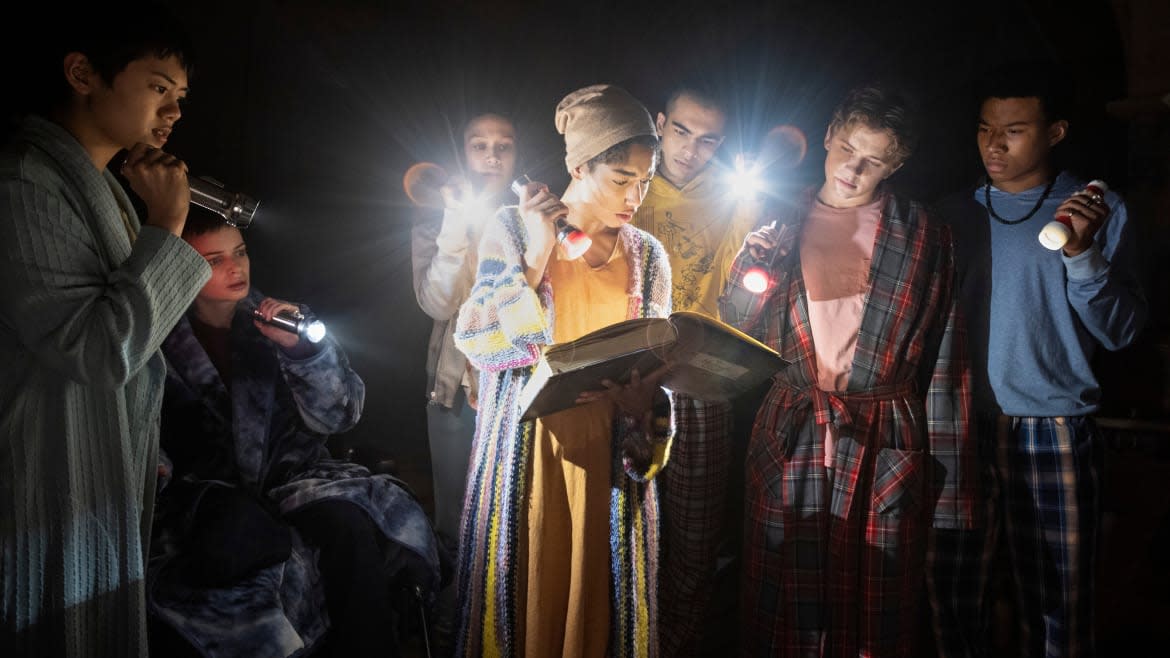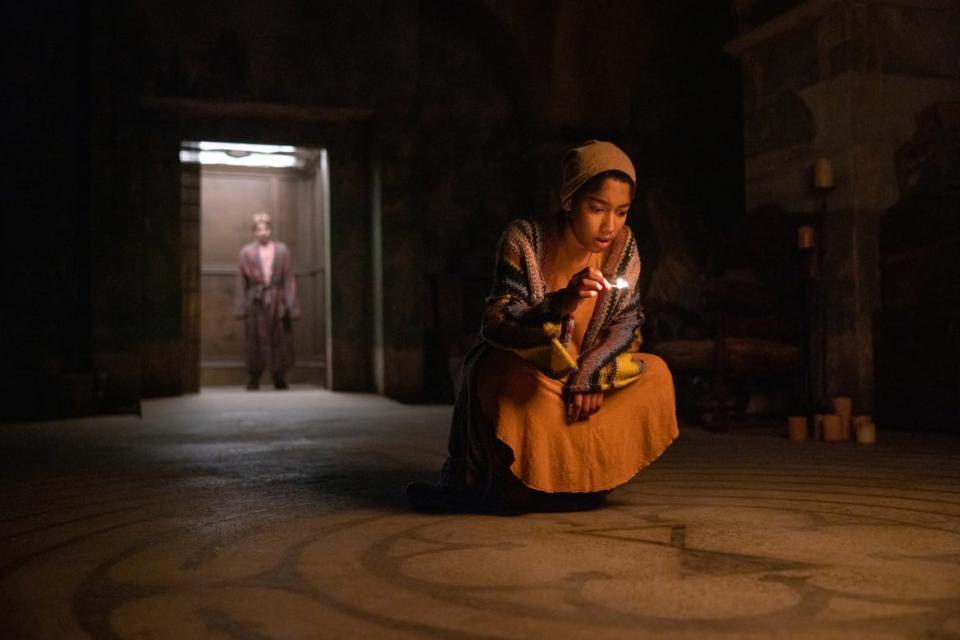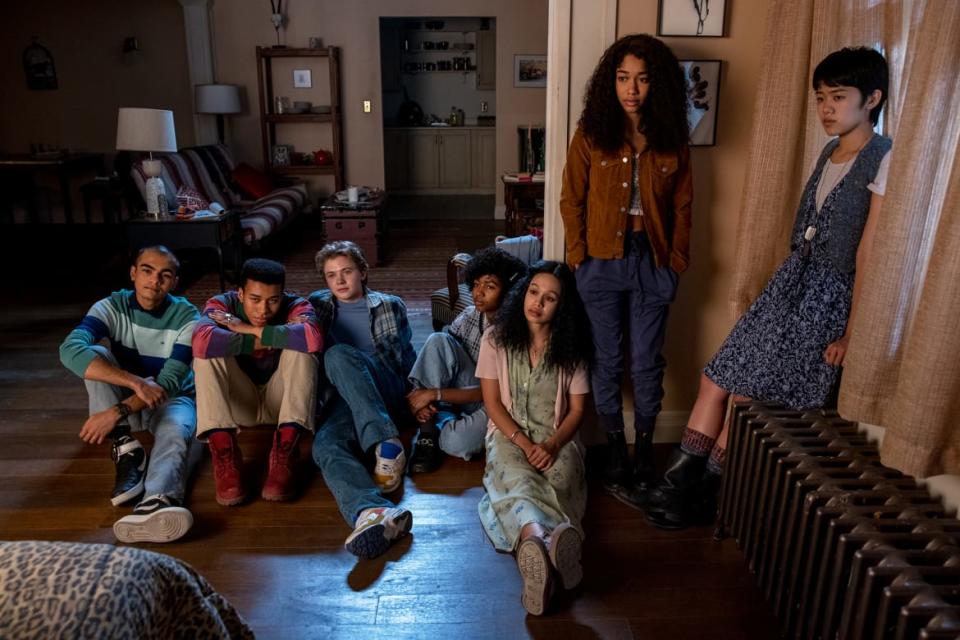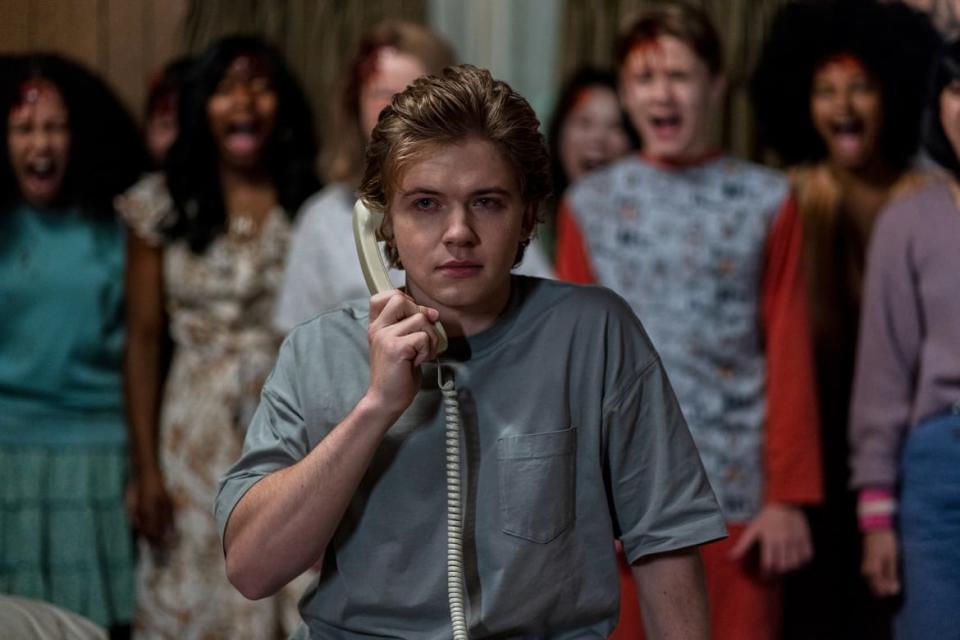For ‘The Midnight Club’ Author, This Netflix Moment Is Long Overdue

Next summer, at his 50th high school reunion, Christopher Pike thinks he might go and finally say something about what he’s been doing since graduation. “I’m curious to see who’s alive and what they did with their lives,” he says But he’s also interested in returning to his suburban LA hometown to admit his poorly kept secret: He’s the author of several best-selling YA novels beloved by teens all through the ’90s and early 2000s.
“It’s funny,” Pike says. At his 20th high school reunion, the last one he attended, “they had a vote for who was the ‘Most Successful’ in life… like a competition. It was interesting to see. I imagine at the 50th anniversary, it will be more intense.” The winner back then was a woman who had become a well-respected surgeon and developed some new medical techniques. “I thought it was really cool, what she had done,” he says, and I can almost hear him smiling on the other end of the line. “But maybe at my 50th anniversary, I'll say, yeah, I had a show on Netflix.”
Yes, you should say that, I tell him. Absolutely yes. It’s a huge accomplishment for one of the defining architects of my pre-teen reading experience—a time spent spelunking in second-hand bookstores for his gloriously risque thrillers about murderous love triangles, horny football stars, cursed VCRs, and time-traveling aliens. The Netflix show is an adaptation of his 1994 horror/mystery novel The Midnight Club, helmed by Mike Flanagan and Leah Fong; Pike serves as an executive producer. Flanagan, the creator of Netflix shows like Midnight Mass and The Haunting of Hill House, is a Pike superfan. He’s spent years trying to make this adaptation happen, and now, it finally has.
‘The Midnight Club’: Netflix’s Teen Horror Series Is Frighteningly Light on Thrills
The Midnight Club revolves around Ilonka, a precocious teen who gets diagnosed with a terminal form of cancer. At a hospice that cares for young people, she discovers that her fellow patients have a secret nighttime ritual where they tell each other horror stories, bound together by a solemn group pact. Known as the Midnight Club, Ilonka learns that it has been around for decades, a tradition started by previous residents at the hospice. When one member inevitably passes on, they must reach out from beyond the veil to prove that there’s something—anything—after death. But as Ilonka starts digging around into the history of her new home, things start to get weird.
The story behind The Midnight Club was drawn from Pike's own experience with a fan. In the 1990s he corresponded with a terminally ill girl who was part of a book club at her hospital that discussed his work; that book club would directly inspire his novel, which he started working on. But “I did not finish [writing] it in time for her,” he says. “She died before I finished it.” He remembers offering her an advance copy of the almost-finished manuscript, but she turned it down. “I sometimes wondered, if I had actually seen her, I would have said no, read it now, read 90 percent of it now,” he says wistfully.

(L to R) Igby Rigney as Kevin and Iman Benson as Ilonka.
When Pike decided to turn his fan’s nocturnal reading club into the premise for a novel, he knew he couldn’t have the kids discussing his own books within it. But Flanagan and Fong’s adaptation is going all in on the Christopher Pike catalog: Each episode will tell a story from one of his other books, which Pike had a hand in shortlisting. “I remember [Flanagan] wanted Monster, Whisper of Death, and Remember Me,” says Pike, who declined because he wants to preserve these novels for potential future adaptations. “So I set aside 10 that he could use that were appropriate to the story. Like Witch, Road to Nowhere—you read these books, and it’s obvious why they would be part of the Midnight Club, why the kids would be talking about them at midnight, if they were in a hospice and they were suffering a terminal disease.”
It makes sense why Flanagan wanted to adapt those books. Stories like Witch are high school dramas turned up to 11, with doomed love triangles and melodramatic teen stereotypes reminiscent of 1980s John Hughes movies. Witch, for instance, is about a girl with supernatural healing powers who gets a little too involved in trying to prevent the future; Road to Nowhere follows a cagey runaway high schooler who turns out to be a less-than-reliable narrator. They’re fine examples of Pike’s juiced-up approach to teen characterization, which (usually, at least for an adult reader) requires both a generous suspension of disbelief and the understanding that the books were produced when America’s social values were still staggering out of the Reagan era.
Inside the Unholy Terror of Netflix’s Daring New ‘The Haunting of Hill House’ Series
Flanagan has taken some creative liberties with a few of the stories for The Midnight Club. Gimme a Kiss, Pike’s 1988 novel about a vengeful teen whose diary gets spread all over school, is transformed into a stylized black-and-white genre piece, for instance; Flanagan and co. also tweaked some of its more dated (albeit stereotypical, purposefully hyperbolized) views on sex and its consequences.
This is the kind of change that some viewers may appreciate, however. Digging through a couple of old-school Pike fan blogs, some folks who revisited his books felt like their themes haven’t “held up” over time. Given that some of them were written in the mid-to-late ’80s, a modern reader may or may not be comfortable with how issues like AIDS, queerness, and abortion were discussed back then. This isn’t to say Pike isn’t aware of how his books may have aged; in a 2019 interview, he discussed the overwhelming whiteness of his characters and rigid beauty ideals that were the norm in American YA publishing.
That said, I’m not sure ’90s teen horror is something that’s supposed to age with us—nor is it possible to simply retcon stories produced in such a culturally homogenous but specific time without losing all sense of social and historical context. Pike was writing books for young people in an era when Sweet Valley High was a primary fictional ideal for a generation of young (Western) readers. We were aspiring to belong to a place where popular kids were extra petty and prickly, and nobody really accepted things like mental illness or eating disorders.

(L to R) Sauriyan Sapkota as Amesh, Chris Sumpter as Spencer, Igby Rigney as Kevin, Adia as Cheri, Annarah Cymone as Sandra, Iman Benson as Ilonka, and Aya Furukawa as Natsuki.
“I don’t know if the books would be the same,”says Pike, when I ask him if he feels like there’s a uniquely ’90s generational quality to his books, or if they had been written during another era. “There was something right then about the internet just starting. No one used the phrase ‘social media’… and we didn't have people walking around with cellphones. It was a different time, and I think the books fit the time.” He’s not wrong; he did, after all, write a whole trilogy about a chain letter, an analog social phenomenon that you’d find difficult to explain to a kid today.
Pike’s work may have exemplified the pre-internet anxiety of that era, but his brand of YA deviated a lot from that of his contemporaries. His often caustic, pulpy voice elevated his books above the average high school fare; for instance, Pike did not shy away from the grim comedy of a rapist accidentally shooting off his own dick, or the incredibly reality-show-premise idea of two ancient goddesses possessing two teen girls to continue a prolonged fight. One of my favorite lines lies buried in the middle of The Last Vampire 2: Black Blood, when the protagonist Sita discusses a plan of attack with her lover Ray.
He nods. “Sounds like a piece of cake.”
“No. It’s a baked Alaska.” I study the structure and nod. “They’ll burn.”
The book covers definitely helped him to stand out, too: deliciously theatrical scenes of terror and isolation brought to life by artists like Brian Kotzky, who illustrated did more than 100 covers for The Hardy Boys. Kotzky’s amazing cover for The Eternal Enemy is my favorite, featuring a startled girl watching television while a Jean-Luc Picard-type stranger in a black turtleneck zones in behind the set, it’s one part ’90s pulp painting, one part Twilight Zone, with an Animorphs-style effect that adds a bit of camp to the mood. This particular generation of Pike’s books, published by Archway/Pocket Books, invokes such instant visual sentimentality that Netflix kept the signature font for The Midnight Club’s title card.
His storytelling was the biggest draw of all, of course. While his love of science fiction endured in books like The Starlight Crystal and The Tachyon Web—still focusing on teens, but with time travel, aliens, and cold hard technology—Pike’s work ran across the genre spectrum. I was particularly fond of The Last Vampire series, a six-book saga that kicks off with centuries-old vampire Sita masquerading as a high schooler; the story was inspired by Indian philosophies and concepts of rebirth and reincarnation. As a hormonal kid hypnotized by the allure of unrealized love against a backdrop of semi-automatic gunfire and human body parts, I didn’t even question the whole “Sita, a blonde white girl, was born in India” thing. To my young lizard brain who just wanted to get through puberty, Christopher Pike was the Wong Kar-wai of doomed, impossible romances, infused with soap-opera level twists and turns.
Most of his books, though, focus on the impossible drama of being a teenager, and ran the gamut from weekend getaways gone wrong and horny diaries to time-traveling aliens and cursed statues. There are drugs and murder schemes and cult rituals. But Pike also has this very matter-of-fact, even droll approach to discussing death and dysfunction in ways that I hadn’t encountered before as a preteen.
When I tell him that I read his books around 12 or 13, he asks, thoughtfully and without judgment, if my parents knew (they didn’t). “I began to realize pretty quickly that there were kids out there that were your age or even younger [reading the books], and that kind of scared me,” he admits. “Maybe scared is the wrong word—it inhibits you a little bit, because that’s not the audience that’s supposed to be reading the book.”
Pike had started writing around 1979, six years before his YA debut Slumber Party. At first, he focused on science fiction and horror. His initial goal was writing for adults—or, at least, not specifically for young adults. (Flanagan is also developing one of Pike’s few published adult novels, 1992’s The Season of Passage, into a film.) But it took him years to get his work out there. In the mid-1980s, however, everything changed when his agent told him a publisher was looking for YA thrillers.
”This was after five or six years of trying to get published, so I was very frustrated and I thought I would never get published at that point,” Pike says. “I was about to quit trying. And that was when I sat down and wrote Slumber Party. I didn't know anything about writing teen books. But I saw there was basically more freedom to do more—I don’t want to say preposterous things—but the intensity of emotions you can have seemed more believable with young adults than adults.”

Igby Rigney of The Midnight Club.
While Pike’s fiction is filled with incredibly anxious, life-threatening scenarios for his hormonal protagonists—The Midnight Club has a particularly potent mix of young, volatile feelings mired in inescapable, impending death—his own recollections of high school paint him as more of a quiet observer.
“I was rather shy, so I never went on a date in high school,” he says. “I went on a date two days after I graduated high school. I ran track, though, and cross country. I also played basketball for a while on the team.” He remembers putting a real disagreement he had with his coach into a scene in his Final Friends series. “There was a character named Michael, and he was trying to convince the coach at halftime that you’re just letting this one guy shoot, he shoots all the time, we’re not running any plays,” he recalls. “And I don’t think it was well received.” High school was also when he got into meditation and yoga after reading Herman Hesse’s Siddhartha; these are practices that he continues today to help him write.
Even now, Pike is still very much drawn to the incomparable intensity of young feelings. He’s working on three novels, two of which are YA. “I’ve been sort of storing them up,” he says. “One of them’s part of a series. I envision that the series could be anything from three to 10 books.” It seems that the emotional turmoil of teenhood is something that stays the same, no matter the social and cultural generational context.
Rest in Peace ‘Peacocktober’: The Streamer’s Hilariously Lewd Halloween Title
It’s fitting, then, that Pike should head back to his old high school and finally get his moment in the sun. He encourages me to call him back next summer so he can tell me how his 50th reunion went—despite his longtime preference for privacy, perhaps this fresh crop of big-screen adaptations will jolt his old classmates into seeing him with fresh eyes. “At the 20-year high school reunion, I remembered everybody’s name. And I was stunned when there would be people in the class that I ran track with, and they go, ‘No, I don’t remember you,’” he says. “And I’d say, I remember every race we had against each other. I remember the time we finished the cross-country course… so I imagine it will be 1,000 times worse at the 50th.”
There’s something poignant about the way Pike—a man known for Remember Me, a story about ghosts among us—wove his literary legacy from a constellation of people who don’t even recall his name. Hopefully The Midnight Club will help jog their memories, and admiration, a bit. But come next June, if Pike’s alumni liaisons still haven’t put two and two together, maybe we’ll get a new kind of horror book.
Get the Daily Beast's biggest scoops and scandals delivered right to your inbox. Sign up now.
Stay informed and gain unlimited access to the Daily Beast's unmatched reporting. Subscribe now.

 Yahoo News
Yahoo News 
